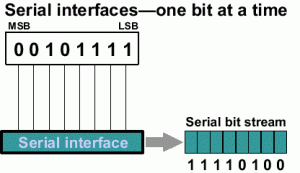SERIAL DATA TRANSMISSION
Serial transmission technology is increasingly used for the transmission of digital data. A large number of up-to-date communications networks apply serial transmission. The numerous applications include computer networks for office communications, Access Control, building and manufacturing automation, Internet etc.
Serial data transmission implies that one bit is sent after another (bit-serial) on a single transmission line. Since the microprocessors in the devices process data in bit-parallel mode, the transmitter performs parallel-to-serial conversion, while the receiver performs serial-to-parallel conversion. This is done by special transmitter and receiver modules which are commercially available for different types of networks.
Characteristics of Serial transmission system:
Serial data transmission is suitable for communication between two participants as well as between several participants. Characteristic features of a transmission system are the direction of the data flow and the data through put, or the maximum possible data rate.
Direction of data flow: Transmission systems differ as to the direction in which the data flow and when messages can be transmitted. Basically, there are three different ways of communication.
- Simplex: data exchange in only one direction.
- Half-duplex: the stations take turns to transmit data and.
- Full-duplex: data can be exchanged in both directions simultaneously.
Point-to-point connection:
In two-point or point-to-point connections, the receiver and transmitter lines can be connected via two separate lines. The receiving line of one participant is the transmitting line for the other one. The communication in such two-point systems can be controlled either by software or via control lines.
The capacity of a communication line cannot sufficiently be defined by the data rate alone. The following parameters especially for networks with several participants are important as well:
- Time period until the line is ready for transmission and
- The number of data to be transmitted in addition to the proper message, such as device address, control information.









December 9th, 2010 at
[…] This post was mentioned on Twitter by iWatchSystems LLC, iWatchSystems LLC. iWatchSystems LLC said: SERIAL DATA TRANSMISSION http://dlvr.it/B3X9r […]
December 21st, 2010 at
[…] SERIAL DATA TRANSMISSION | Technical […]